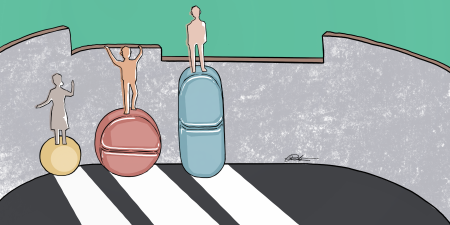Abstract
As of 2020, North America is now into the fifth year of an unprecedented increase in drug overdose deaths driven by a toxic, unpredictable, and unregulated drug supply. While the genesis and drivers of and response to the opioid overdose crisis have wide regional variations, structural violence, prohibitions against illicit drug use, and stigma consistently play a central role. The criminalization of users of illicit drugs has led directly not only to users’ incarceration, but also to their marginalization and isolation and to violence, entrenched poverty, and a vicious cycle of trauma. This policy has created an environment wherein any initiatives to prevent and reverse overdoses have been severely restricted. While a war on drugs and the people who use them has been widely criticized as destructive and unwinnable, the criminal policies that support the war on drugs have not changed even in response to this unprecedented crisis.
Context of the Opioid Overdose Epidemic
The opioid overdose epidemic claimed more than 134 000 lives in the United States and more than 12 000 lives in Canada between 2016 and 2018.1,2 In the United States, overdose deaths contribute more to reduction in life expectancy than chronic lower respiratory diseases, Alzheimer’s, or flu, and, in British Columbia, Canada, overdose deaths contribute to a decrease in life expectancy among those of lower socioeconomic status.3,4 Although much of the media focus has been on prescription opioids, the majority of overdoses result from illicit drugs containing synthetic opioids with unpredictable potency.5 People buying these drugs run the constant risk of using toxic drugs and overdosing. The primary narrative that has emerged in the media and that dominates the public discourse has been to target those most affected,6 including the people who use drugs, the communities that have been hardest hit by the crisis, and, more recently, the pharmaceutical companies that manufacture prescription opioids.7 However, the criminal policies that support the war on drugs have not changed even in response to this unprecedented crisis. The criminalization of users of illicit drugs has led directly not only to users’ incarceration, but also to their marginalization and isolation and to violence, entrenched poverty, and a vicious cycle of trauma.
Response Paralysis
At all levels, and by any measure, the response to such a massive and ongoing loss of life has been inadequate, as it has focused on prescribing and its downstream effects. Nearly all 50 states have prescription drug monitoring programs (ie, databases that track controlled substance prescriptions) that provide health or law enforcement authorities with access to clinical data on prescribing patterns.8 The Centers for Disease Control and Prevention has focused specifically on monitoring trends, enhancing data collection, partnering with health systems to treat addiction and with community organizations and first responders to prevent overdoses, and increasing public awareness about opioid use risk.9 In British Columbia, Canada, a public health emergency was declared in April 2016 that resulted in expanding treatment options, scaling up naloxone programs, and opening up new safe injection sites across the province.10 Although these initiatives have saved lives, there has been little movement on drug policy reform or on dealing with the contaminated illicit drug supply.11
The failure to act more decisively can only be explained by the entrenched discrimination and stigma against people who use drugs. In fact, laws, such as the harsh criminal penalties associated with drug possession and sales,12,13 along with cultural norms and institutional polices, “encode” stigma, thereby reducing public support for policies to rectify the opioid overdose crisis.14 Criminalization puts the responsibility and blame for opioid use firmly on the individuals at risk. Basically, the underlying assumption is that if people are willing to use drugs that are prohibited and toxic, then it is their own fault. Making something illegal means that policymakers can deny people the most basic harm-reduction interventions or treatment options without fear of backlash.
In general, harm-reduction strategies remain controversial throughout North America despite overwhelming evidence that these interventions are pragmatic, effective, and necessary. Needle and syringe exchanges to reduce the transmission of HIV and other blood borne infections, methadone and other opioid substitution therapies to reduce illicit drug use, and supervised injection sites to connect people with services and eliminate overdoses15,16 are all evidence-based interventions. Yet, in response to the opioid overdose crisis, many jurisdictions have blocked community-led harm-reduction interventions and pursued even stricter enforcement measures.17 The ongoing battle to open a supervised injection site in Philadelphia is a case in point.18
In any other epidemic, such as an infectious outbreak, we would not even consider criminal enforcement as a response. Saving lives would be the priority. Our first response should be to provide a nontoxic, regulated alternative.19 In the case of the illegal opioid market, it is clear that removing the toxic product is just not possible, which should leave no alternative but to provide safer options in the form of a regulated opioid program. In Vancouver, 2 studies demonstrated that providing a safer injectable opioid in the form of heroin20 or hydromorphone21 was feasible and effective. Scaling up the Vancouver program has proved to be difficult, however, despite evidence of its efficacy.22 Programs with lower barriers to participation that use low-cost hydromorphone pills are currently being piloted in Canada.22
Structural Violence
The barriers to reducing opioid-related harms are a manifestation of structural violence. The term structural violence was first introduced by Johan Galtung, a Norwegian sociologist who was a leader in peace and conflict studies. He defined structural violence as “violence [that] is built into the structure and [that] shows up as unequal power and consequently as unequal life chances” and as “predicated on social injustice.”23 Paul Farmer used structural violence to help explain the HIV epidemic in Haiti.
Making something illegal means that policymakers can deny people the most basic harm-reduction interventions or treatment options without fear of backlash.
“Structural violence” is one way of describing social arrangements that put individuals and populations in harm’s way. The arrangements are structural because they are embedded in the political and economic organization of our social world; they are violent because they cause injury to people.24
In the opioid overdose crisis, it is not just the drugs that are causing harm but the social arrangements (ie, criminalization of drug use, isolation, and homelessness) that have created such a dangerous environment for people. It is notable that these structures are largely arbitrary, ideological, and unchallenged.
Much of the structural violence experienced by drug users is built upon and perpetuated by prohibition and law enforcement. The basic tenant of enforcement is based on a belief that punishing people for drug use will be a deterrent to further use and serve as an example to people who might consider using drugs in the future. This approach has clearly been ineffective, as illicit drug use continues to rise, the illegal market becomes more unpredictable, and more people end up in the criminal justice system for drug-related offences.25,26 The increase in opioid overdose deaths is a tragic but predictable outcome of this failed strategy.
Ethical Responses
At the core of the response to the current opioid overdose crisis is the unspoken discrimination against and willful neglect of many of society’s most vulnerable people. The opioid overdose crisis has exposed the tragic reality of how little we can do when the dominant response to illicit drug use is based on prohibition and criminal enforcement rather than on a broader sociomedical approach.
We don’t often think of personal drug use as a human rights issue, but, arguably, it is one. In 2016, Human Rights Watch and the American Civil Liberties Union released a report on the criminalization of drug use in the United States, the summary of which concluded that “enforcement of drug possession laws causes extensive and unjustifiable harm to individuals and communities across the country.”27 The people impacted by the criminalization of drug use are poorly organized and often hidden, as drug use is illegal and highly stigmatized. People using drugs face numerous barriers with regard to employment, housing, food security, and health care, while spending much of their time in the criminal justice system.28 Despite these barriers, drug user groups can be a critical force for change, and there are good examples of how people using drugs have changed drug policy. The Supreme Court of Canada’s decision to keep open InSite, North America’s first legally sanctioned supervised injection site, was largely due to the advocacy of drug users in Vancouver.29
If personal drug use is a human right, then addressing drug use and addiction will require a much broader approach. The best interventions proposed and practiced in the medical community will always be limited within the confines of a system in which drugs are illegal and the people using them must turn to sources that are entirely unregulated and often toxic. An ethical response to the opioid overdose crisis must include providing a strong social support system, breaking down stigma and discrimination, improving access to addiction treatment, and promoting harm- reduction interventions. Physicians and physician groups can play a major role in all of these areas by including social support in their treatment plans, actively breaking down stigma by treating patients with respect, offering evidence-based addiction treatment, and promoting harm reduction. These interventions could greatly improve health care outcomes and reduce opioid overdose deaths. In addition, physicians should be at the forefront of challenging drug laws and a criminal justice system that inflicts so much harm on patients and their families. If we do not recognize and address the drivers of drug use, challenge destructive drug policies, and tear down the pillars of structural violence, we will not see real change.
References
-
National Institute on Drug Abuse. Overdose death rates. https://www.drugabuse.gov/drug-topics/trends-statistics/overdose-death-rates#:~:text=Drug%20overdose%20deaths%20rose%20from,in%202018%20to%2067%2C367%20deaths. Published March 10, 2020. Accessed June 9, 2020.
-
Government of Canada. Opioid-related harms in Canada. https://health-infobase.canada.ca/substance-related-harms/opioids. Revised December 11, 2010. Accessed February 1, 2020.
-
Dyer O. Declining US life expectancy is driven by more than just opioids, study finds. BMJ. 2019;367:l6753.
- Ye X, Sutherland J, Henry B, Tyndall M, Kendall PRW. At-a-glance—impact of drug overdose-related deaths on life expectancy at birth in British Columbia. Health Promot Chronic Dis Prev Can. 2018;38(6):248-251.
-
Wilson N, Kariissa M, Seth P, Smith H IV, Davis NL. Drug and opioid-involved overdose deaths—United States, 2017-2018. MMWR Morb Mortal Wkly Rep. 2020;69(11);290-297. https://www.cdc.gov/mmwr/volumes/69/wr/mm6911a4.htm. Accessed June 8, 2020.
-
Webster F, Rice K, Sud A. A critical content analysis of media reporting on opioids: the social construction of an epidemic. Soc Sci Med. 2020;244:112642.
-
Keefe PR. The family that built an empire of pain. New Yorker. October 23, 2017. https://www.newyorker.com/magazine/2017/10/30/the-family-that-built-an-empire-of-pain. Accessed June 9, 2020.
- Cerdá M, Ponicki WR, Smith N, et al. Measuring relationships between proactive reporting state-level prescription drug monitoring programs and county-level fatal prescription opioid overdoses. Epidemiology. 2020;31(1):32-42.
-
Centers for Disease Control and Prevention. Opioid overdose: Overdose Data to Action. https://www.cdc.gov/drugoverdose/od2a/index.html. Reviewed September 3, 2019. Accessed June 9, 2020.
-
Provincial health officer declares public health emergency. BC Gov News. April 14, 2016. https://news.gov.bc.ca/releases/2016HLTH0026-000568. Accessed June 9, 2020.
- Irvine MA, Kuo M, Buxton JA, et al. Modelling the combined impact of interventions in averting deaths during a synthetic-opioid overdose epidemic. Addiction. 2019;114(9):1602-1613.
-
Justice Laws website. Controlled Drugs and Substances Act (SC 1996, c 19). https://laws-lois.justice.gc.ca/eng/acts/c-38.8/page-2.html#h-94406. Accessed June 9, 2020.
-
England DC. Selling Oxycontin/oxycodone: penalties, laws, and defense. Nolo. https://www.criminaldefenselawyer.com/legal-advice/criminal-defense/drug-charges/selling-oxycontin-penalites.htm. Accessed June 9, 2020.
-
Tsai AC, Kiang MV, Barnett ML, et al. Stigma as a fundamental hindrance to the United States opioid overdose crisis response. PLoS Med. 2019;16(11):e1002969.
- Wood E, Tyndall MW, Montaner JS, Kerr T. Summary of findings from the evaluation of a pilot medically supervised safer injecting facility. CMAJ. 2006;175(11):1399-1404.
- Des Jarlais DC, Feelemyer J, LaKosky P, Szymanowski K, Arasteh K. Expansion of syringe service programs in the United States, 2015-2018. Am J Public Health. 2020;110(4):517-519.
-
Nadelmann E, LaSalle L. Two steps forward, one step back: current harm reduction policy and politics in the United States. Harm Reduct J. 2017;14(1):37.
-
Feldman N. Bill to prevent supervised injection sites from opening in Philly advances. WHYY News. March 9, 2020. https://whyy.org/articles/bill-to-prevent-supervised-injection-sites-from-opening-in-philly-advances/. Accessed June 9, 2020.
-
Fischer B, Pang M, Tyndall M. Applying principles of injury and infectious disease control to the opioid mortality epidemic in North America: critical intervention gaps. J Public Health (Oxf). 2019;fdz162.
- Oviedo-Joekes E, Brissette S, Marsh DC, et al. Diacetylmorphine versus methadone for the treatment of opioid addiction. N Engl J Med. 2009;361(8):777-786.
- Oviedo-Joekes E, Guh D, Brissette S, et al. Hydromorphone compared with diacetylmorphine for long-term opioid dependence: a randomized clinical trial. JAMA Psychiatry. 2016;73(5):447-455.
- Tyndall M. An emergency response to the opioid overdose crisis in Canada: a regulated opioid distribution program. CMAJ. 2018;190(2):e35-e36.
- Galtung J. Violence, peace, and peace research. J Peace Res. 1969;6(3):167-191.
-
Farmer PE, Nizeye B, Stulac S, Keshavjee S. Structural violence and clinical medicine. PLoS Med. 2006;3(10):e449.
- Camplain R, Camplain C, Trotter RT II, et al. Racial/ethnic differences in drug- and alcohol-related arrest outcomes in a Southwest county from 2009 to 2018. Am J Public Health. 2020;110(suppl 1):S85-S92.
-
Sentencing Project. Trends in US corrections. https://sentencingproject.org/wp-content/uploads/2016/01/Trends-in-US-Corrections.pdf. Accessed June 9, 2020.
-
Human Rights Watch. US: disastrous toll of criminalizing drug use. https://www.hrw.org/news/2016/10/12/us-disastrous-toll-criminalizing-drug-use#. Published October 12, 2016. Accessed June 9, 2020.
-
Shefner RT, Sloan JS, Sandler KR, Anderson ED. Missed opportunities: arrest and court touchpoints for individuals who fatally overdosed in Philadelphia in 2016. Int J Drug Policy. 2020;78:102724.
-
Kerr T, Mitra S, Kennedy MC, et al. Supervised injection facilities in Canada: past, present, and future. Harm Reduct J. 2017:14(1):28.



